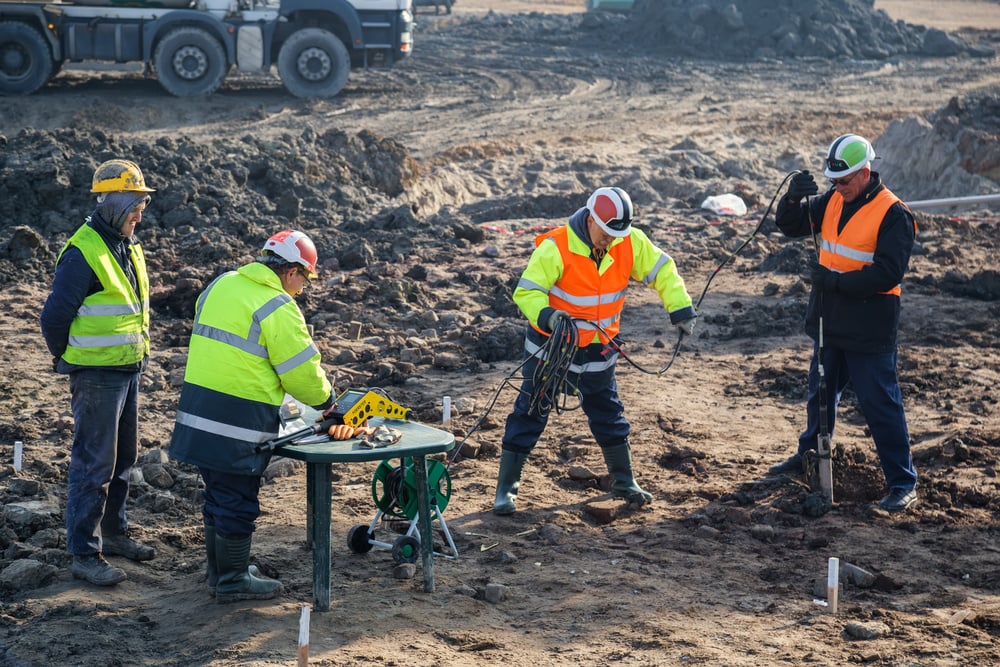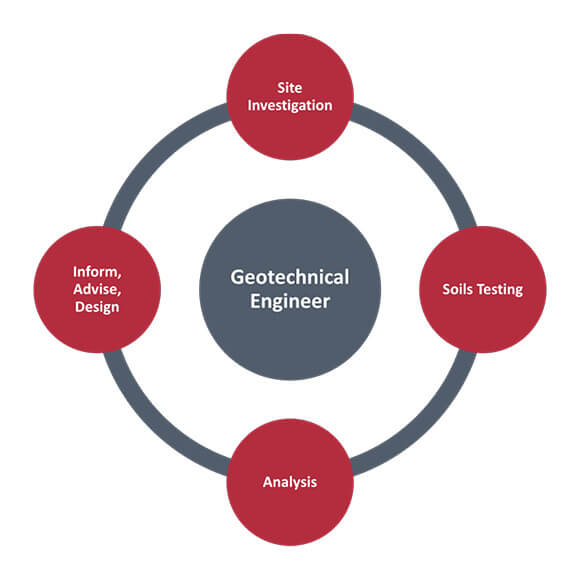Facts About Geotechnical Engineering For Construction Projects Uncovered
Rumored Buzz on Geotechnical Engineering For Construction Projects
Table of ContentsWhat Does Geotechnical Engineering For Construction Projects Do?Geotechnical Engineering For Construction Projects Can Be Fun For EveryoneGeotechnical Engineering For Construction Projects Can Be Fun For EveryoneMore About Geotechnical Engineering For Construction ProjectsGeotechnical Engineering For Construction Projects for Beginners8 Simple Techniques For Geotechnical Engineering For Construction ProjectsGeotechnical Engineering For Construction Projects Fundamentals Explained
Concepts and Practice of Ground Improvement. Ground Enhancement Concepts And Applications In Asia. Layout analysis in rock auto mechanics.Cengage Knowing, Stamford, 666 p. Atkinson, J., 2007. The auto mechanics of dirts and structures. Taylor & Francis, N.Y., 442 p. Drifting Offshore Wind Generators: Reactions in a Sea state Pareto Ideal Styles and Economic Evaluation, P. Sclavounos et al., October 2007. Nicholson, D, Tse, C and Cent, C. (1999 ). The Observational Approach in ground design principles and applications.
The Facts About Geotechnical Engineering For Construction Projects Uncovered
Lab and area testing plays an essential duty in this procedure. By drawing out samples from the earth's subsurface and applying a suite of examinations, geotechnical designers can predict the behaviour of dirt layers and examine their viability for various building efforts. The essence of geotechnical engineering in civil engineering can not be overstated, attributable to numerous elements: The initial action in any geotechnical research includes identifying the soil kind at the building website.
The structure acts as the bedrock of any construction project. Selecting the proper foundation type is a decision that pivots on the extensive evaluation given by geotechnical design.

Geotechnical site examination is an important step in the planning and execution of any building and construction project. It includes the collection and evaluation of information associated with the physical homes of soil and rock under a suggested construction website. This details is essential for the layout and building of risk-free, steady, and lasting frameworks.
The Greatest Guide To Geotechnical Engineering For Construction Projects
, also understood as subsurface exploration, includes a series of tasks aimed at identifying the dirt, rock, and groundwater problems at a building and construction website. The primary purposes are to determine prospective geotechnical hazards, assess the design properties of subsurface materials, and supply recommendations for the style and building and construction of structures, retaining walls, and other structures.
The workdesk research aids in determining potential geotechnical issues and preparing the succeeding fieldwork. This includes observing the topography, drain patterns, existing frameworks, vegetation, and any kind of signs of instability or disintegration.
Excitement About Geotechnical Engineering For Construction Projects
Superficial examination pits are dug deep into to straight observe and sample the dirt and rock. This approach serves for studying the upper layers of the subsurface and identifying near-surface threats. Non-invasive geophysical techniques, such as seismic refraction, ground-penetrating radar (GPR), and electrical resistivity tomography (ERT), are made use of to map subsurface conditions and detect abnormalities.
Soil and rock samples gathered during the field investigation are subjected to lab screening to establish their physical and mechanical buildings. Typical laboratory examinations consist of grain dimension analysis, Atterberg limits, compaction tests, triaxial shear examinations, and consolidation tests. These examinations supply vital information for geotechnical evaluation and layout. The information accumulated from the desk research study, site reconnaissance, area examination, and lab testing are assessed and interpreted to develop a detailed understanding of the subsurface problems.
The key advantage of geotechnical site examination is making certain the safety and security of frameworks. By recognizing the subsurface problems, engineers can create structures and various other architectural elements that can withstand the loads and environmental forces they will go through. This minimizes the danger of negotiation, decrease, and structural failing.
The Single Strategy To Use For Geotechnical Engineering For Construction Projects
For instance, understanding soil characteristics can guide the option of excavation techniques, dewatering approaches, and ground renovation actions. This makes sure effective and risk-free building methods. Geotechnical website investigations are typically required by developing codes and policies. Sticking to these demands ensures conformity with lawful and security requirements, staying clear of potential discover here lawful obligations and project delays.
This details is vital for project supervisors, architects, and contractors in establishing realistic timetables, budgets, and backup strategies. Geotechnical Engineering for Construction Projects. Skyscraper in a Coastal AreaIn a seaside city, a skyscraper residential structure was intended on a site with presumed loosened sand deposits and a high water table. A detailed geotechnical examination, including borehole drilling, CPT, and geophysical surveys, was conducted
The smart Trick of Geotechnical Engineering For Construction Projects That Nobody is Talking About
Based Check This Out upon these findings, the foundation style was modified to include deep stack structures expanding right into steady strata, and ground renovation strategies, such as vibro-compaction, were applied to minimize liquefaction dangers. This positive technique made certain the security and stability of the structure while staying clear of pricey post-construction removal. Infrastructure Development on a Sloping TerrainA significant facilities project, involving the construction of a freeway and bridges, was intended on an uneven terrain with high inclines.

The Leaning Tower of Pisa (Italy), a legendary building wonder, is well known for its unplanned tilt from considerable geotechnical issues. The tower's structure was inadequately made to take care of the soft, unpredictable dirt under it, bring about unequal settlement and its unique lean. Our globe is dotted with remarkable framework projectsfrom looming high-rises to stretching bridgesall standing statement to the advancement of the different building and construction equipment and methods readily available.
Geotechnical engineering is a specialized area within civil engineering that concentrates on researching the habits of planet products. This branch dives deep right into the groundinvestigating exactly how the dirt, rock, and groundwater at a building website can influenceand be affected bythe facilities that we erect on and right into them. Prior to a solitary block is laid or a concrete structure poured, geotechnical designers probe into the earthgathering essential data concerning the site's soil structure, rock framework, and groundwater levels.
Getting The Geotechnical Engineering For Construction Projects To Work

is a tool utilized to evaluate the honesty and load-bearing capacity of stacks throughout installment, leveraging the principle of wave breeding. It enhances construction efficiency by offering real-time assessments, hence making certain safe and effective pile foundations. One of the practical applications of geotechnical engineering involves determining and executing the appropriate approaches for foundation building and construction.
Pile driving represents more than the simple act of placing structural aspects into the ground. As a matter of fact, it is a thoroughly orchestrated process of transferring a framework's load past the much less stable soil layers more detailed to the surfacedown to the extra significant strata that lie beneath. When it comes to heap driving, take into consideration just how geotechnical engineers skillfully utilize this technique to equally distribute the framework's weight.